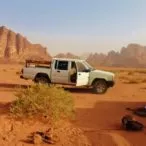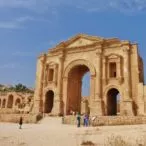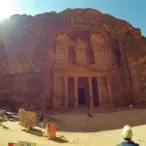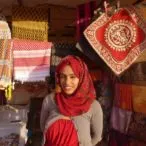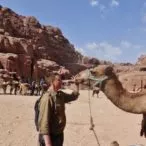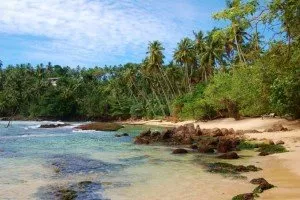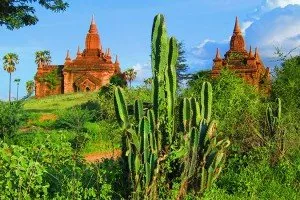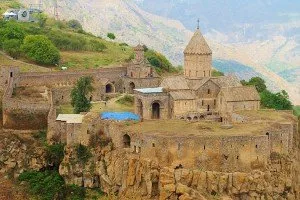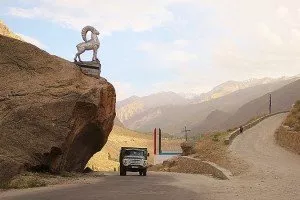Jordan
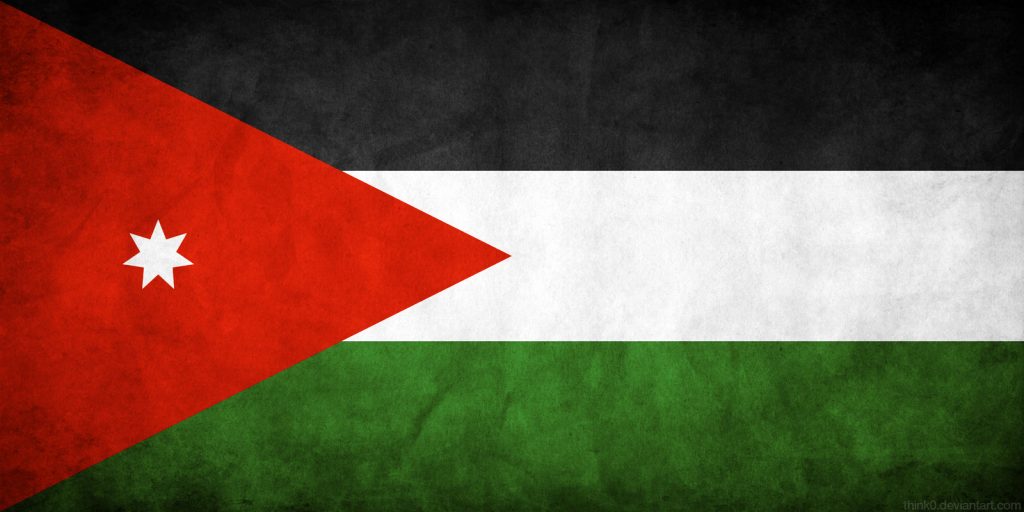
Official name: the Hashemite Kingdom of Jordan
Population: 7 880 000
Area: 89 342 km²
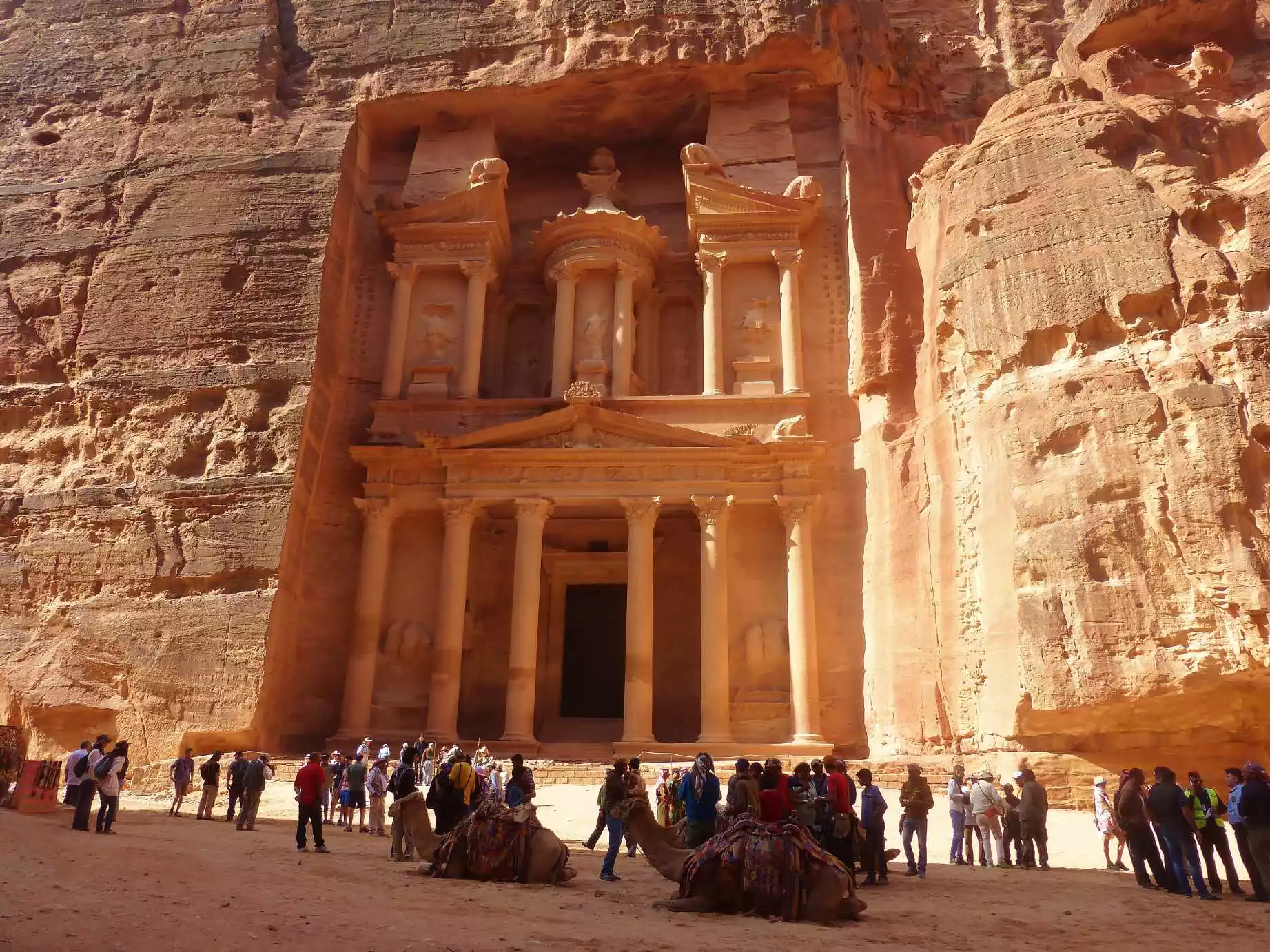
Gallery
Tourist attraction of Jordan, Jordan – the present times, history of Jordan.
Tourist attraction of Jordan
Jordan is small but a rich in tourist attractions Arab country. Despite its small territory, slightly larger than Ireland we can travel through deserts, canyons, mountains, enjoy the seas, try good food, and above all we can see Petra which is one of the new Seven Wonders of the World. Jordan is located in the region where war is a part of everyday life but fortunately the country is still safe for tourists and it becomes increasingly attractive. The historical richness and the natural beauty of Jordan does not leave travellers indifferent and it provides interesting experiences and beautiful memories. It is also worth noting that even though on one hand the continuous wars, conflicts and terrorist attacks in the region do do any favours to Jordan, then on the other hand every year Jordan gains new visitors because it is seen as a stable country in the region. A few times I also came a cross a comparison that Jordan is called “Thailand of the Middle East” and I think that because of its attractions this statement is true to a certain degree. Either way I do not advise White women to travel alone in any Muslim country. The main travel path of Jordan is in the west of the country along the border with occupied Palestine, although a few travellers also set off to conquer the hot sands in the direction of Saudi Arabia and Iraq.
The first tourist attraction of Jordan was the capital city itself – Amman. I lived in the old district near the Roman theatre and it was where for the first time I felt the true nature of Jordan. In the vicinity of the Al Husseini mosque there are a lot of fruit stalls, gift shops and counterfeit perfumes and cheap restaurants offering traditional Arabic dishes. The old part of the city was a convenient starting off point for the impressive Roman Theatre, the Hippodrome and the Citadel on the top of the mountain where there are views of the entire Amman. The city let me feel the daily life of Jordanians where I had experiences such as a visit in a busy eating house proudly called a restaurant and a very risky haircut done by an Arab barber who eventually able to shave goats but not people.

Panorama of Amman, the capital city of Jordan in the colour of a desert.
From Amman I organised two trips which I would like to recommend to everyone. First I went to the well-preserved Roman ruins of Jerash which are located about 53km north of Amman. Due to its large area and interesting sights such as traditional Roman theatre, impressive streets, columns and big gates I spent there whole day.
I also went on a two-day trip across the desert. I went west to the town of Azraq to see the sand castles built about 1,000 years ago. The desert and the hitchhiking were both great adventures but some of the castles that are worth seeing are Azraq, Qusayr Amra, Qasr Qharana and Qasr al Hallabat. Then, after passing through the chaotic Zarqa bus station I got to the cave of 7 sleepers and went back to Amman.
About 45 km to the south of Amman is the mosaic city of Madaba, where the main attractions are the old churches, with impressive, Christian mosaics. When in Madaba, it’s also worth paying attention to the art studios, where tourists can see artists at work, and then buy mosaics created from local rocks. Madaba is not just about the city itself, but it is also a base for other interesting places. During the one-day trip, I first went to Mt Nebo, the Christian place from which Moses saw the promised land, and where today, if the weather is good, Palestine / Israel can be seen. Then, by hitchhiking through the mountains I reached river Jordan where John the Baptist baptized Jesus. This was also my first contact with Israel, because river Jordan is a natural border between the two countries. From there, through a sandstorm, I finally reached the Dead Sea, but I was not happy because it was raining and the beach was very dirty. Besides, from Madaba I also went to the Roman ruins of Mukawir, where once stood the castle of Herod the Great, and from where we can see Palestine and the Dead Sea.
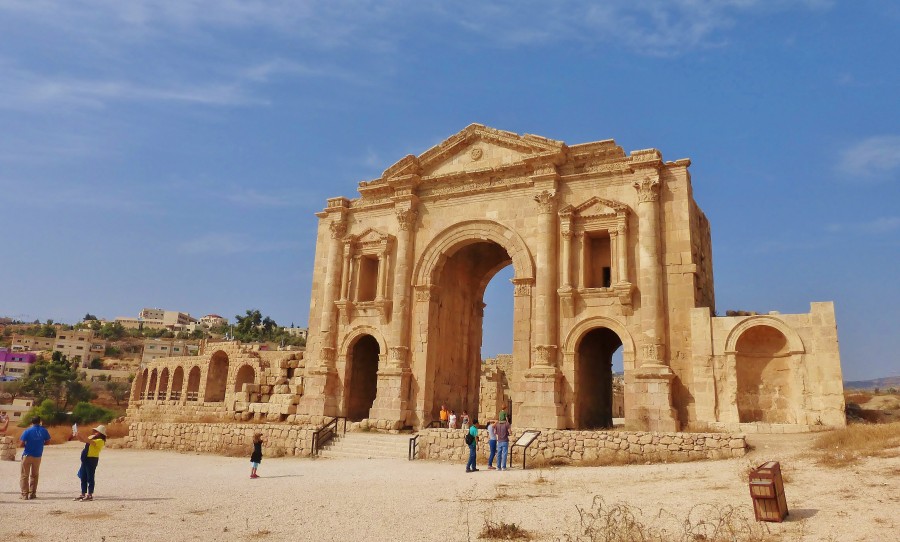
The Hadrian’s Gate in Jerash.
My route further south led by an uninspiring town of Dhiban and the beautiful canyon of Wadi Mujib. After many hitchhiking options and many adventures I finally got to the city of Karak with its impressive castle built by the Crusaders in 1142. Because the castle in Karak is the only attraction I organised a one-day trip from there. I went through the mountains to the village of Mazraa and then by hitchhiking I reached the Dead Sea. Over it was clean and the weather was nice. By an accident I saw Israeli fighter jets patrolling the border.
I also have very fond memories from the Dana Nature Reserve. Dana was a place where I relaxed in natural surroundings. I walked through the mountains and valleys, went through narrow canyons and saw flocks of sheep. Dana is a reserve of many beautiful views and trees wrapped around rocks of different colours that let tourists forget the stench of everyday life. Besides, I lived in the village of Dana constructed of rocks which was a very special place. Not far from there is also Shobak castle built in 1115 by the Crusaders. This castle was quite easy to visit because it was located near the road towards Petra and I assure everyone that it is worth a visit. Many tourists bypass it because they had already seen other places or they may not have the time but the built on top of the mountain Shobak castle is a great site and it beautifully presents itself from a distance.
Then I got to the tourist town of Wadi Musa which is the base town to Petra – one of the Seven Wonders of the World. Petra is worth exploration even if it was located at the end of the world. It is a beautiful mountainous journey through the desert where we can admire the ancient temples carved in the rocks, caves and spectacular rock formations and canyons. Petra can be of course explored on foot but if someone has great style he can explore it on a donkey, a camel or a horse cart.
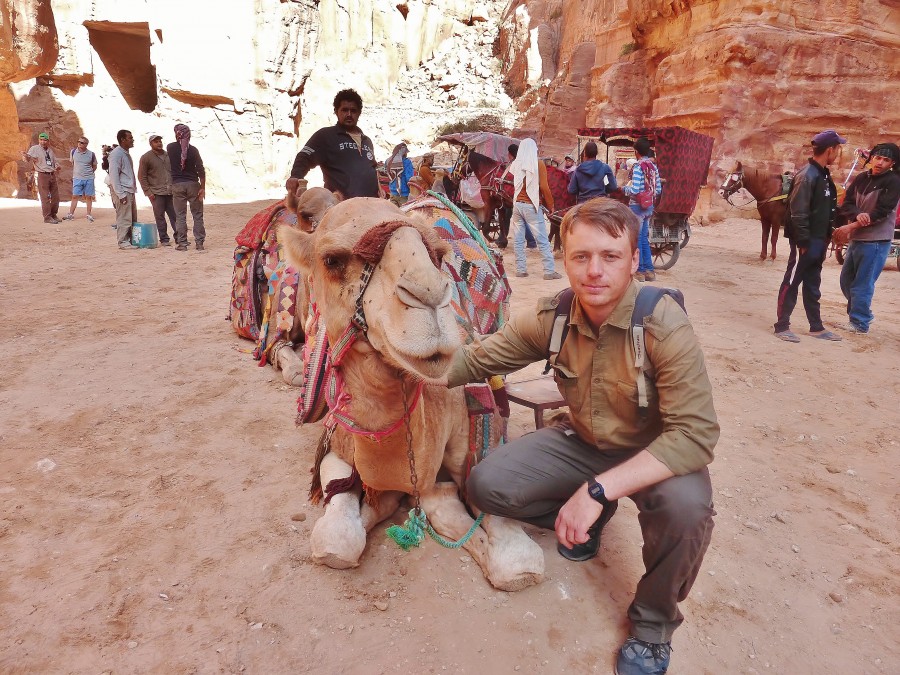
With a camel in famous Petra.
Another great attraction of Jordan is a desert trip in Wadi Rum. It was here the first time where I walked the desert alone experiencing its peace and beauty. I climbed sand dunes and mountains from where I watched the panorama of Wadi Rum. I had tea with Bedouins and I spent lonely nights in the desert warming up by my own fires. In addition to Petra which no longer needs to be advertised, the desert of Wadi Rum is a very special place that gives unforgettable experiences of our Jordanian adventure and helps to understand the identity of the Arab country.
Finally I hitchhiked to the town of Aqaba by the Red Sea. I saw the Citadel and the Jordanian flag on the high mast but in Aqaba I primarily swam in the sea and took a good rest after the hardships of the desert and mountain expeditions. In Aqaba I had to slow down to come back to my usual self. I had regular meals and I drank tea with bakhlava in Arab bars. Aqaba was my last place in Jordan which turned out to be a pleasant reward after crossing the whole country.
Apart from all the places that I mentioned it is also important to discover new places beyond the tourist trail. I’m talking about the places that provide good insight into reality of Jordanian life; the forgotten transport rat holes and all those dirty town that travellers go through without wondering about what a life of an average Jordanian looks like. I’m talking about places in Amman where no one usually sees a White tourist or a place such a Dhiban between Madaba and Karak where Arabs were so excited about one White man that they became very tired and began to very tiring. Another town of that kind was Al Qadisiya near the Dana Nature Reserve where I saw poverty, emptiness and boredom and where I heard loud Muslim propaganda from the speakers. Whilst in Karak I walked through holey streets and talked with young Arabs about Islam what once again showed me that Arabs are professional liars who are able to say absolutely anything just to defend Islam. I remember a bus station in the town of Zarqa where chaos, poverty and garbage flown by the wind are indeed the real Jordan. These are the places that we would never see on postcards but it is important to remind about their existence because an average tourist arrives only to Jordan for a few days to see Petra, Wadi Rum and Aqaba and then he believes that he knows Jordan. No, he doesn’t. I know Jordan because I saw it with the eyes of a traveller who looks for realism in his expeditions.
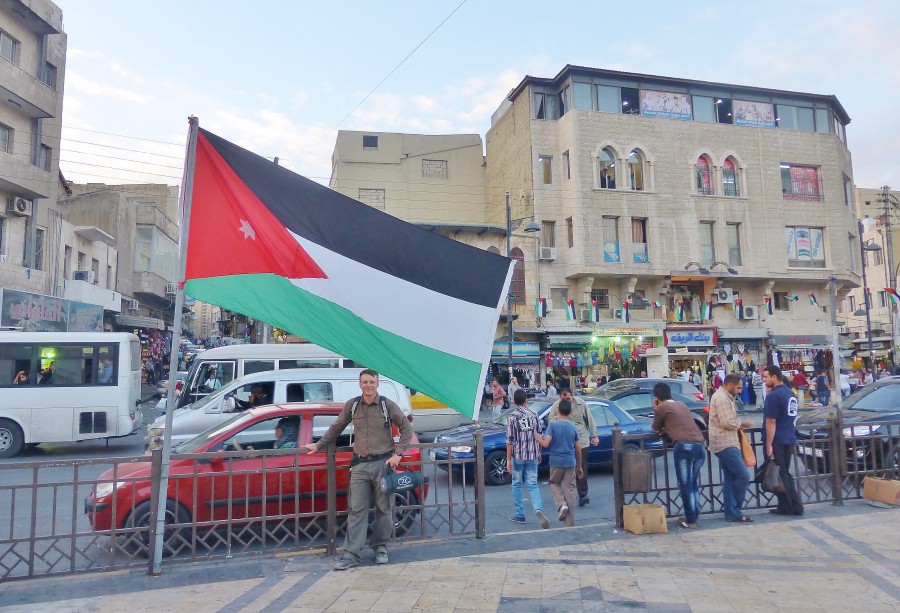
In Amman, with a flag of Jordan.
Jordan – the present times
Economy
Despite its location in a region of frequent wars and humanitarian crises, Jordan is considered to be a rising economy. Jordan has a free trade agreement with the United States, EU, Canada, Singapore and several countries in the Arab world. Anti – restrictive, open economy also allowed Jordan to avoid the financial crisis in 2008-10 and the well-developed banking sector is attractive to foreign investors. The main problem of Jordan which stops its economic growth is the lack of water because it’s a hot and dry Arab country whit very low rainfall and where only 10% of land is suitable for cultivation, and even this modest percentage is hard to maintain because of of lack of water. Besides Jordan does not have coal reserves, hydroelectric power, oil stocks or forests and it is fully dependent on imported oil and energy. In addition, a huge knockout to the Jordanian economy is the regional instability and Syrian refugees, who also cost a lot of money and who also need water. For that reason the major branches of the Jordanian GDP are tourism, foreign aid and the money sent to Jordanian banks by emigrants.
In order to stimulate the economy the Jordanian government has made rapid privatization which turned out to be much better than a centrally controlled economy. Thanks to that they developed Amman, Aqaba – border resort on the Red Sea, and six special economic zones. The main branches of industry (10% of GDP) in addition to the above are: textiles, chemicals, fertilizers, mining, pharmaceuticals, cosmetics, defense and communication as well as all kinds of services (77% of GDP). Inflation stands at 5%, unemployment at more than 12%, the annual GDP per one person is about $6,000 and the national GDP in 2012 reached above $31bn. Annual GDP growth is 3%. In 2001 up to 12.5% of the population of Jordan lived below the poverty line.
All economic comparisons Jordan does quite well. According to the World Bank Jordan is a “country of medium to high earnings,” and according to the Index of Economic Freedom Jordan is on the third place in the region of West Asia and North Africa, behind Bahrain and Qatar, and is 32nd in the world. Jordan has also the 35th best infrastructure in the world and the banking sector of the country is considered to be highly developed. Jordanian market is one of the most developed ones out of Arab countries outside of the Arab Peninsula. In 2010 Jordan was classified as the 19th most expensive country in the world to live and the most expensive Arab country in general, although in that I simply do not believe after comparing Jordan to the petrol rich Arab countries in the region.
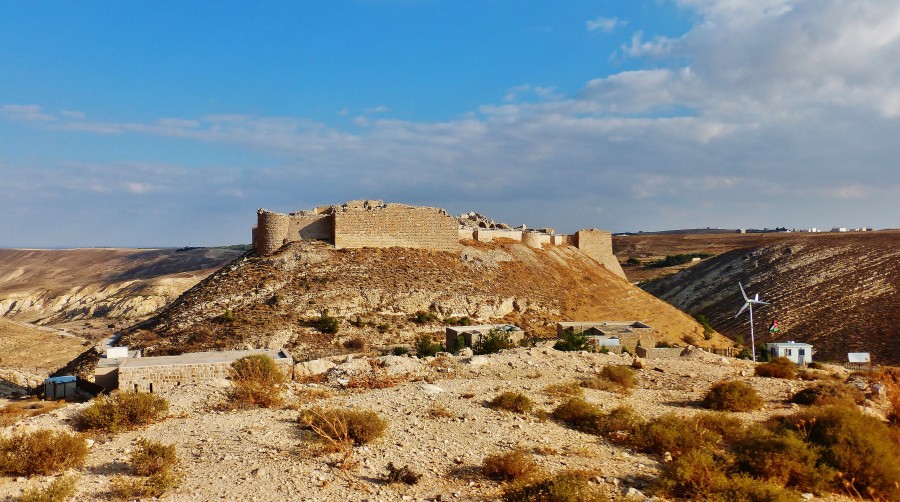
Shobak castle – less visited but attractive .
Unfortunately the standard of living in Jordan is not high what I saw whilst traveling around the country. Jordan is very under-funded and its regions far from the major cities are dirty and poor. Without the foreign aid and billions in payments by Jordanian expatriates working mainly in Saudi Arabia and the Arab Emirates, Jordan would have a lot more trouble. Jordan is the third largest recipient of remittances in the Middle East after Lebanon and Egypt. As a result of it Jordan continues to grow and is trying to be equal to the rich Arab countries, although in my opinion, as an eyewitness I think that Jordan has still a long way to achieve that. However, Jordan can pride itself with its economic miracle, the small port city of Aqaba which thanks to its convenient location and attractive investment package can become an important player in the region. The main problem for Jordan is of course Israel which despite the peace agreement does not allow Jordan to establish trade relations with the West Bank and with the Gaza Strip and it never stops upsetting Arabs in every possible way. Israel is the dirty rat of the Middle East.
In my opinion Jordan unnecessarily opened borders to Syrian immigrants because according to the World Bank 630.000 refugees cost Jordan $2.5bn a year and that money could be spent on the local infrastructure, health system or development of new technologies rather than on unskilled workers with ever-demanding attitude to life. I suspect that the war in Syria was started also to weaken the economies of the Arab countries, despite the fact that Jordan did not start that war and does not owe anything to anyone.
Education
The level of education and the educational system in Jordan is an example for other Arab countries. Jordan spends approximately 14% of its GDP on education and has made great progress at all levels of education. As a result of it Jordan has 2000 scientists per 1 million people while the average for the other countries is 500 people per 1 million. Also, in spite of limited financial means Jordan is on 95th place out of 187 countries on the Human Development Index list; and many other countries in the region have developed their educational systems using Jordan as the example. Jordanian level of education is at the international level and high school graduates are accepted at renowned universities. According to the CIA Factbook level of literacy in Jordan stands at 95.4% and according to UNESCO it is 96.7%. Either way Jordan has the highest literacy rate of all the Arab countries, whilst by far the worst situation is in Yemen (70%).
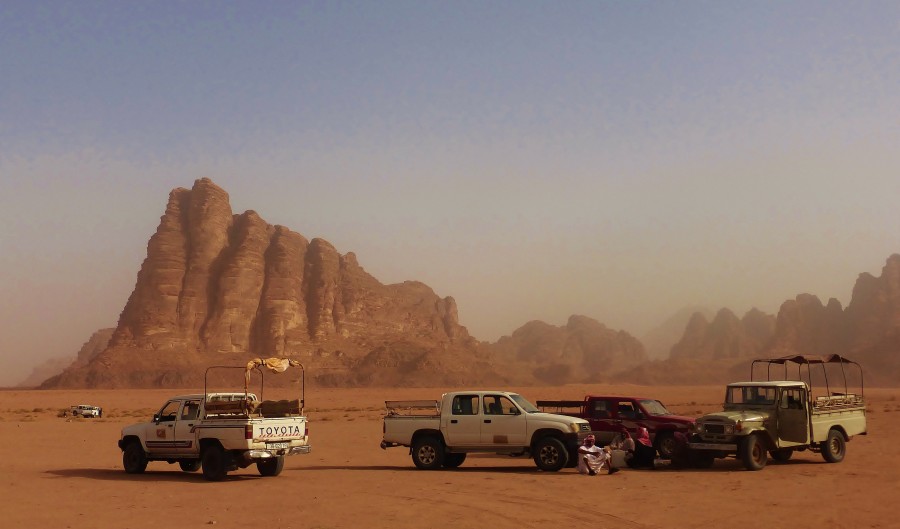
Expedition to the Wadi Rum desert.
Small Jordanians start their education from the 2-year-old kindergarten. Then there is a mandatory 10-year-old primary school and two years of high school. Primary schools in 2007/08 enrolled 95.7% of children, which is more than the regional average which stands at 93%. This is partly because the Jordanian Ministry of Education is trying to spend money not only in cities but also in villages, to reach also the poorest and to include both boys and girls.
Education at the secondary level takes two years and is intended for students aged 16 to 18 who completed 10 years of secondary school. At the secondary level young Jordanians must learn 9 compulsory subjects, such as: Arabic, mathematics, social sciences, computers, earth sciences, chemistry, biology, physics and Islamic studies – although Christian youth is exempt. Secondary schools educated in a general way and it ends with an exam called Tawjihi which opens the way to universities, although there is also vocational training, other than Tawjihi, which is set to a particular labour market. Every year to secondary schools are enrolled 89% of students, where women outnumber men by 3%. In comparison with the neighboring countries secondary school attendance is 25% higher. Despite such good statistics Jordan still has to work harder to improve the quality of teaching because in comparison to other Arab countries Jordanian students have worse results than students in other countries with similar expenditure on education. Jordan scores badly at mathematics and social subjects and on average 30% of students drops out of high schools before completing the 11th year of education.
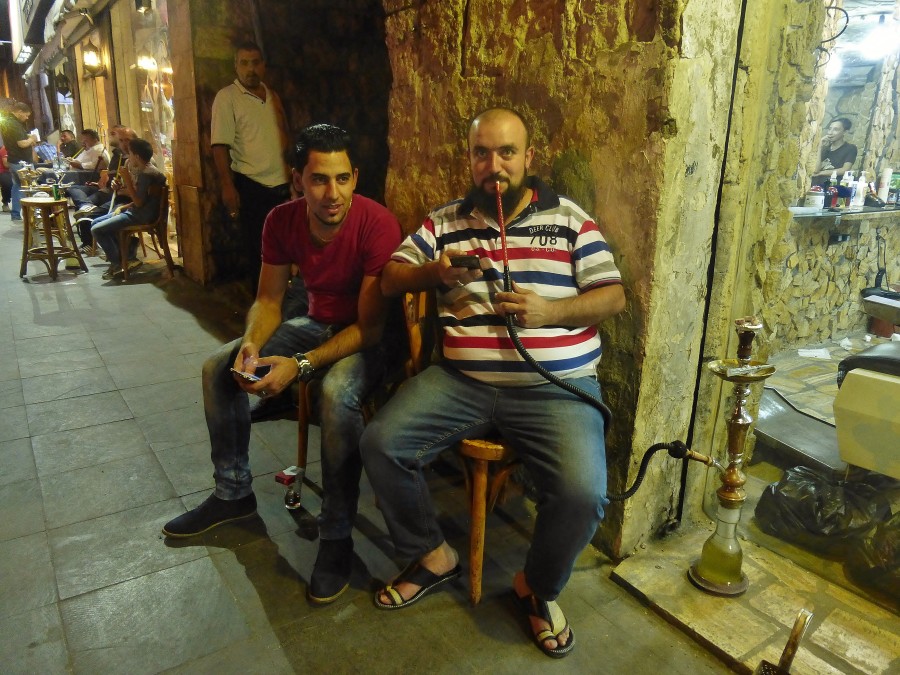
Arabs smoking shisha in Amman.
Unfortunately when it comes to higher education students from homes with higher earnings have better chances. On average about 2.5% of Jordanians enter universities and both state and private universities have higher enrollments every year. State universities enjoy rise in enrollments by 14% a year and private ones by as much as 18%, which puts increasing emphasis on the educational system of Jordan, in a world where economy is increasingly based on specialist knowledge.
In Jordan there are also free schools for Palestinian children in refugee camps which are funded by the United Nations. Some of the Palestinian refugees send their children to Jordanian public schools but it is a small percentage because to those primary schools is enrolled about 87% of children, while to vocational schools more than 54%.
More than half of Jordan’s population is below 30 years of age. Approximately 42.2% is 14 or less and 31.4% is between 15-29 years old. This means that almost 30% of the population of Jordan attends schools and that’s why this situation puts great weight on the education system and requires a major investments in the form of building of new schools and universities as well as teacher training whose teaching methodology does not always go with the pace of development of technology and the requirements of potential employers. This means that the subjects taught are not always up to standard with the knowledge required for employment, what results in unemployment. Meanwhile, schools are overcrowded and there aren’t enough teachers to the number of students. This means that not everyone is interested in learning and sometimes not everyone is able to hear the teacher despite the fact that everyone wants to have a diploma. For example higher education needs immediate funding because it stands at only 0.65 of GDP, what means that Jordan performs worse in comparison to other Arab countries in the region which spend about 1.6 of GDP.

Qasr Al-Kharanah Castle, near Azraq, in the direction of Iraq.
Health
Jordan has an advanced health system even though it is not distributed equally. Annual spending on health care is around 9% of GDP and the World Bank recognized Jordan as a leader in the region and fifth in the world. Besides, Jordan is the health tourism destination, especially for people living in the Middle East and North Africa but not only. For example, in 2007 and 2008 Jordan cured 250.000 patients for more than a billion dollars. Apart from Palestinians, Iraqis and other Arabs, in the same year Jordan also cured thousands of Americans, British and Canadians because a high standard of treatment is combined with costs of about 25% lower than those in the US. Moreover, Jordanian doctors practice in reputable institutions in the United States.
Health service in Jordan is divided into state and private and most Jordanians have health insurance. The NHS has 27 hospitals, 1,245 medical clinics and 37% of all hospital beds. There are also 11 military hospitals with 24% of hospital beds in the country, while the private sector includes 56 hospitals and 36% of beds.The average life expectancy in Jordan is 74 years and 99% of the population has access to fresh water. It is a big achievement because Jordan is on the list of water impoverished countries but despite that consumption of water per citizen is comparable with Western developed countries. In addition, the average infant mortality rate is 15 per 1000 births and mortality rate of children under 5 is 19 per 1000. Over 95% of children under 5 get standard vaccination and malnutrition stands at less than 5%.
It is also worth mentioning that the hunger agenda is a tool to control a country; and for example in neighboring Iraq before the American invasion 19% of the population was malnourished but after the US invasion it was already 28%.
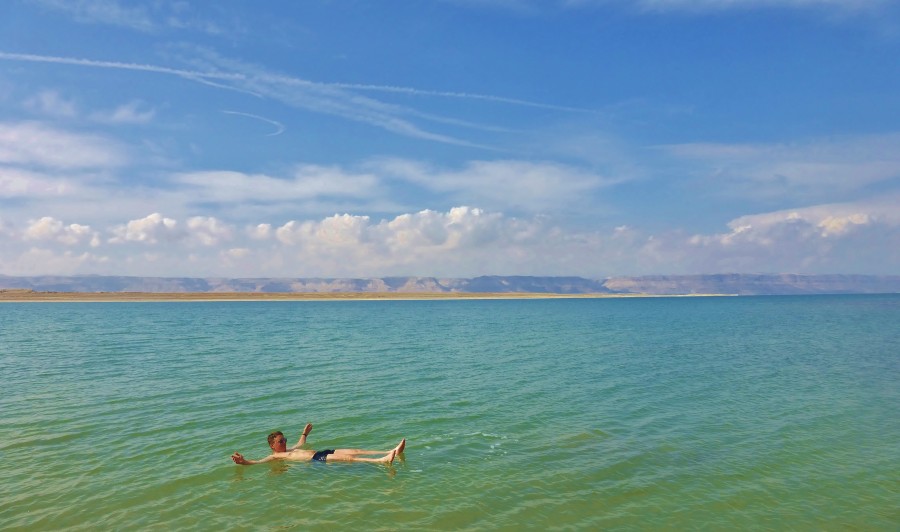
I floated like a rubber duck on the Dead Sea. In the background: occupied Palestine.
When it comes to HIV / AIDS, according to statistics from 2003 0.1% of the population suffered from the virus. Besides, Jordan has been malaria free since 2001 although there are still cases of tuberculosis and in that field Jordan must still improve. I also think that we should take into account that a statistical Jordanian burns 1372 cigarettes a year and that’s why it is not surprising that cancer a big health concern.
Culture/Religion
Jordan is an Arab country located between Israel / Palestine, Syria, Iraq and Saudi Arabia. Although everyone in Jordan is called Jordanian, the understanding of ethnic origins there are very clear. Jordanians are those who before 1948 lived east of the Jordan River, Palestinians come from the west bank of the Jordan River while Bedouins, who are considered to be of the purest Arab blood live in the south of the country. Bedouins have lived for thousands of years in traditional desert way, moving within dry areas in search of better pastures for their animals and without paying attention to the borders. Palestinians are considered to be well-educated, hard-working and having a good contribution to the economy. Jordanians on the other hand are Arabs who left the traditional Bedouin life and accepted life on the principles of the modern Arab world.
Here we can argue of course because behind the word “modern” there is a lot of good but also a lot of evil. Europe and the Arab world perceive modernity in different ways because in the politically correct Europe modernity means degeneration and fight with its own culture, whilst in the Arab world modernity means technological progress while at the same time preserving their cultural traditions.
The majority of Jordanians are Muslim and Islam plays a very important role in the social and cultural life. They listen to prayers from mosques 5 times a day and in many parts of Jordan imams are also political leaders. 92% are Sunni and 1% are Shiites. In Jordan, there are also Christians (6%), mainly Orthodox and Catholics and they live mainly in the city of Amman and Madaba. Other religions are just 1%.Every family preserves patriarchy what means that the leader is the oldest man and after his death his eldest son takes care of the family. Patriarchy is obviously stronger if the enlarged family and if a man has great wealth and many children and grandchildren. In Jordan caste system is also quite popular, what means that young couples are chosen by the families of the same social classes with similar finances. Marriage usually initiates the father of the young woman and couples often do not see themselves before the announcement of the engagement. Marriage and having children are the highest priority and the course is scheduled in a very precise way. First of all, a woman before marriage must be a virgin. Secondly, after discussing the conditions of marriage by both families and after signing the conditions of marriage at the engagement party the couple is officially married. After wedding the woman is under full control of her husband and cannot apply for a passport or leave alone anywhere without the written consent of her husband. At any time the husband can take the second or even third and fourth wife without the consent of his first wife. When it comes to divorce, children automatically remain under the control of the father and a divorced woman is seen as an outcast of the society. For that reason women choose to be in a marriage, even if there are other wives. In Islam women have very little rights and for that reason even when it comes to inheritance women get half of what men do and after divorce women can end up on the street, penniless and without their own children.
On the other hand, we can complain that women in Islam have no rights, but this is the reason why Islam is strong. In Europe women have all the rights and for that reason there is chaos. White women give birth to our racial enemies and engage in destructive feminism. Keeping women on a short leash is necessary for the survival of our White civilization.
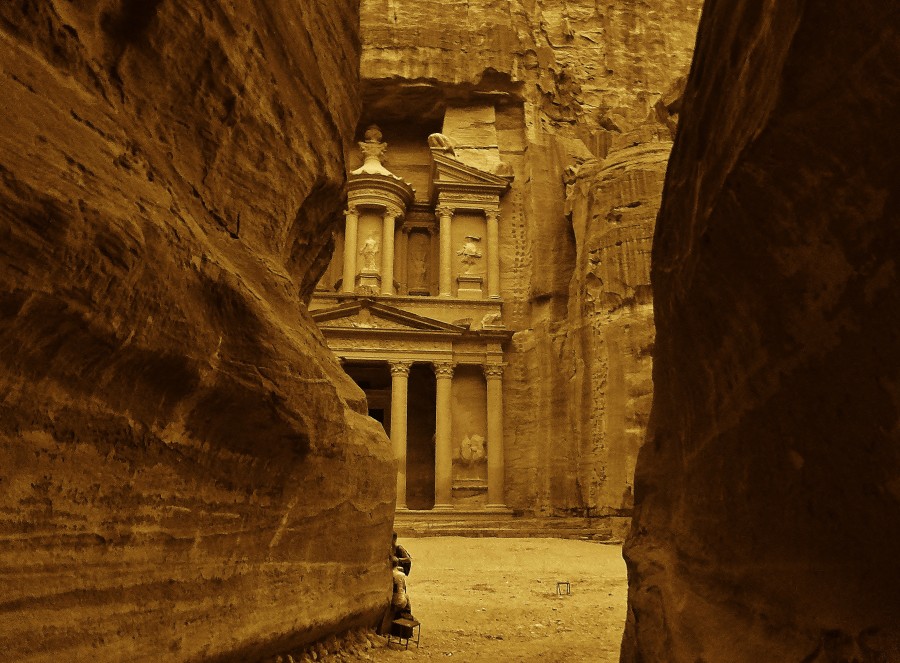
The Treasury seen from the Siq Gorge. Petra.
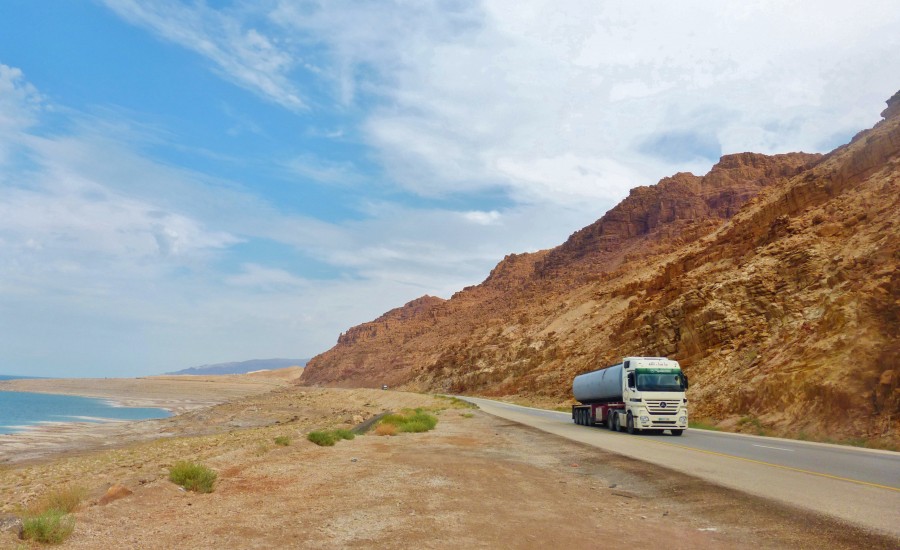
Jordan – a photo of the road. Dead Sea on the left.
Women have to dress in the traditional Muslim way by covering their heads and not wearing tight clothes. Women take care of home and children while men work, though more and more women occupy very good positions because they are better educated than men. Nevertheless, women in Islam knows their place and even if they have good jobs and high positions, the priority is the family. Jordanians are hospitable and I realized it whilst traveling with Bedouins through Wadi Rum. The standard etiquette is to serve Arabic coffee or tea and I had to clearly let them know that it was enough. It is also important to note that if a traveller is invited to a Jordanian home then he should give a small gift at the entrance.
Food in Jordan has also a cultural background and has a variety of spices, sauces and herbs in its menu. Jordanian food is based on poultry, lamb or beef and it is cooked, grilled, baked and enriched with garlic, onions and additionally flavored with lemon juice. This is typically bread or rice and as one of the largest producers of olives in the world, in Jordanian cuisine there is no shortage of olive oil and a very popular humus. The national dish is mansaf which derived from the Bedouin traditions and which is usually served on special occasions. This dish is made of bread called sherack and lamb, yogurt and nuts. Sometimes, instead of bread, rice is served. When I was in the coastal town of Aqaba I invited myself for a grilled fish although schawarma and kebabs are also very popular. We can therefore easily say that the Jordanian cuisine is partly Mediterranean, partly Arabic and Turkish and in my opinion it is similar to Lebanese cuisine. On the streets of Amman, most of the time I had sugar cane drinks and fruit juices, such as for example from pomegranate. For desert I had bakhlava.
As for the newspaper, most of them are in Arabic, although there are two newspapers in English. Cinema in Jordan also occupies an important role in Jordanian life. The most popular, a cult film is “Laurence of Arabia” and “Indiana Jones and the Last Crusade” because both those films were filmed in Jordan. Recently “Martian” was shot in the Wadi Rum desert. The most popular sport is definitely football which has already conquered all Arab countries while the second important discipline is basketball.
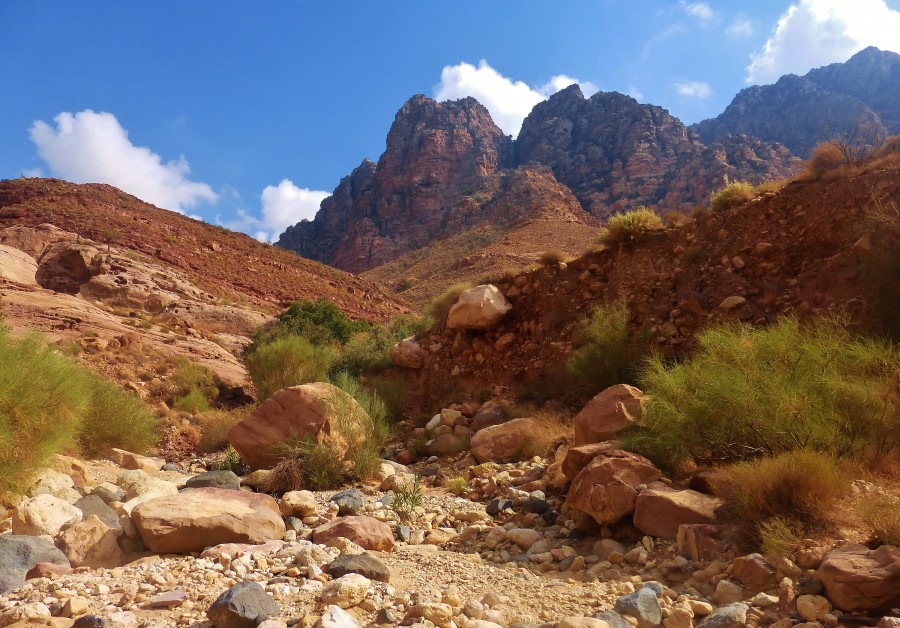
Dana canyon.
Media
In theory freedom of speech and press in Jordan is guaranteed by the constitution but the reality is quite different. Journalists have lawsuits for writing their version of truth about politics and religion. The government justifies itself by fighting potential terrorism which could arise due to some journalists’ opinions and that’s why the Jordanian government controls the flow of information on social media. In 2011 the Jordanian government even introduced a clause about fighting corruption but ironically it arrested only those journalists who were fighting corruption. In Jordan there are special courts which deal only with the press, although in their opinion it is a necessary move in order to not to “offend other people’s feelings.”
Internet in Jordan is also in theory free but from 2012 anyone who has a website must obtain a license to operate. In Jordan nobody can speak badly about the Royal Family and it is not allowed to insult Muslims “to not to cause a rebellion.” Additionally, persons who owe websites must control their users’ comments and every website, both domestic and foreign can be blocked if it does not meet the standards of the Jordanian law. Only in 2013 Jordan blocked 300 websites due to “licensing reasons”.In Jordan the government allows delicate criticism of politicians and ideas of the opposition, but it is only a theatre which is designed to control them even further. The evidence of that is that opposition journalists are regularly intimidated, one was brutally beaten and all members of the Parliament and their crimes are protected with immunity. However, those journalists who are protected and who cannot be intimidated are either fired or bribed. In other words all media in Jordan are subject to strict censorship, although the government makes every effort to show Jordan as the country of freedom of speech.
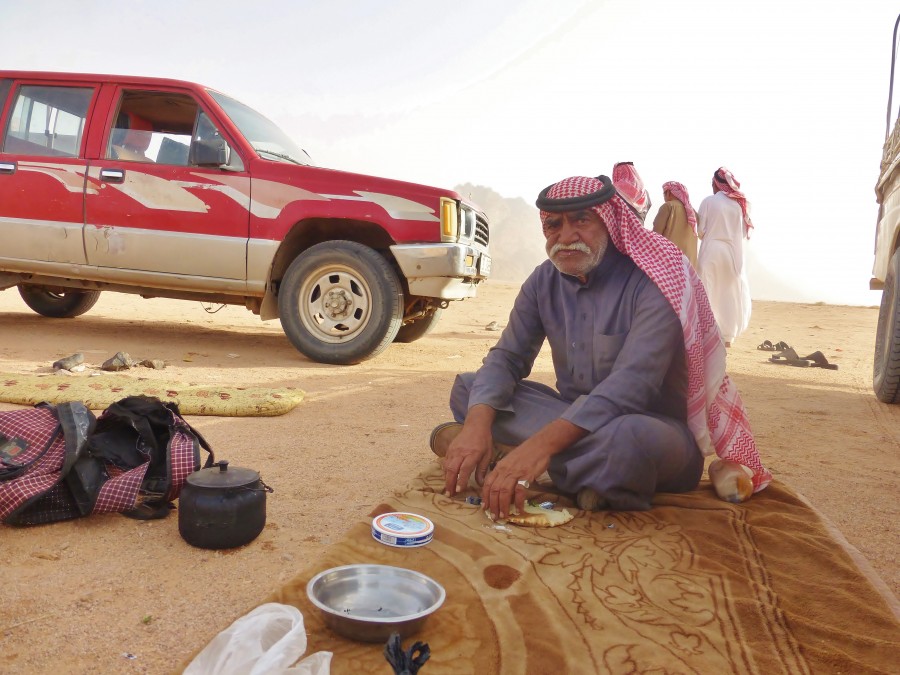
This Arab is not pretty, but at least he’s funny. Wadi Rum desert.
Environmental issues
Jordan is a small country but it has significant ecological problems. Among many of the most serious of them are: limited access to fresh water, excessive deforestation, loss of species, air pollution, littering of the country, excessive grazing, degradation, soil erosion and desertification of green areas. All these issues and many others are associated with the growing population and growing industry while development of Jordan is achieved at the expense of nature.
Air pollution is becoming obvious to tourists walking around Amman. Traffic in Amman on narrow streets creates gray clouds of carbon dioxide which prevent from breathing or riding a bike. In 2006-2008 Amman had 471,500 registered cars which served 1.5 million people. Cars in Jordan are usually old and produce twice as much carbon dioxide and three times more hydrocarbons than new cars. In addition, old cars consume more energy and 31% of cars are bad quality diesels which additionally emit more carcinogenic gases than new cars. Near Amman there is a city of Zarqa where 35% of heavy industry of Jordan is produced. Those are for example: The Oil Refinery of Jordan, factories and steel pipes, Assamra aimed at water purification and a power station. Zarqa is the most polluted city in Jordan and the power plant alone is responsible for the emission of sulfur dioxide.One of the most harmful industries is the cement production in Fuhais, located 15 km from Amman and it fills air with a whole array of poisons, such as: soot, sulfur compounds, hydrocarbons, nitrogen oxides and carbon monoxide. It is also worth noting that CO2 from cement production contributes to 5% of global CO2 emissions. Dust coming from the chimneys of factories contains high concentrations of metals that are toxic to living creatures. Apart from that in the dry climate of Jordan dust cannot fall and it is spread by winds. It is a vicious circle because despite all the poisons the industry of course keeps on growing due to a growing population. According to the World Bank in 1990 Jordan’s population was 3.2 million, in 2000 – 4.8 million and in 2013 – 6.5 million. World Bank has predicted that due to the insanely high fertility of Arabs and because of victims of war and immigration from neighboring countries the population of Jordan will rise and poisonous industries with it. There aren’t too many green areas in Amman and there aren’t even too many trees but instead they continue to build houses and roads. Jordanian cities are breeding grounds for lung cancer, coronary heart disease, heart attacks, vision problems and ultimately also death.
According to one study only as a result of air pollution every year die 51 children under the age of 5. For comparison in Egypt it is even worse because number of children deaths is 123. Apart from that gases coming out from factories and cars, including toxic DDT are the major causes of acid rain, destruction of the ozone layer and UV radiation. Especially for Jordan which suffers from water scarcity it is a terrible blow because less than 12% of the country is suitable for cultivation. Jordan also experiences the problem of salinity of surface waters which is used for irrigation, which in turn makes it unfit for irrigation crops. By the way, the annual rainfall in Jordan is only 111mm which is one of the lowest in the world.
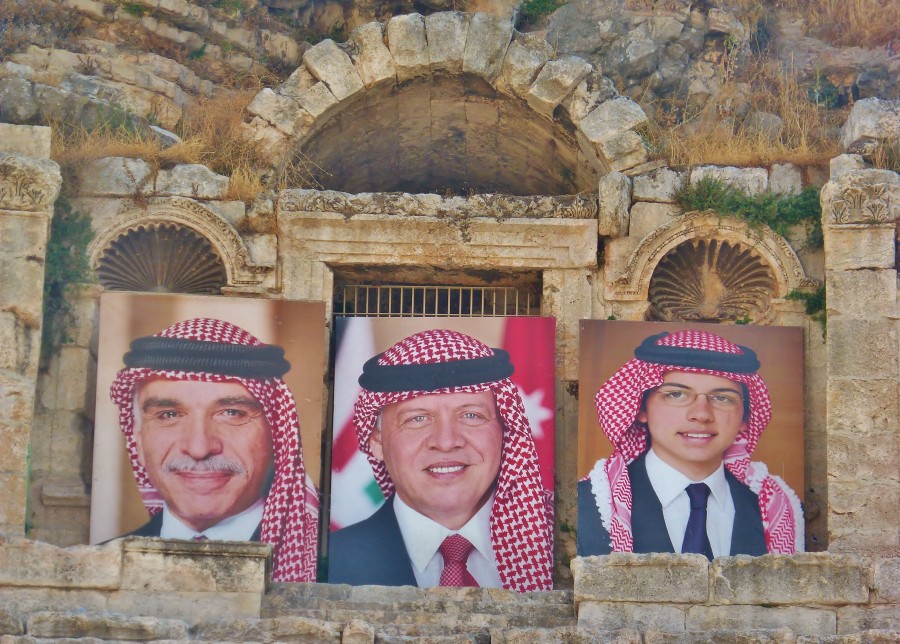
The Three Musketeers of Jordan. Good luck!
Other problems are deforestation and desertification of the country. The Bible sometimes refers to Jordan as a “land of milk and honey” but today it is definitely different. Deforestation of Jordan takes place because of demand for firewood, using land for cultivation and overgrazing cattle what prevents recovery of pastures. In the years 1908 – 1917 Ottoman Turks cut out large areas of forest to use them to fuel their Hijaz Railway from Damascus to Medina. Deforestation has destroyed the natural ecosystems of animals and plants and soil eroded because of removal of roots that held the outer part of the soil in place. Then rains washed away the top layer of earth which accelerated desertification.Jordan once had many species of animals, including: ostriches, gazelles, Arabian oryxes, ibexes, Asian lions, bears and fallow deers. It is also believed that there were crocodiles in the Jordan River. However, many of these species were either decimated or brought to extinction due to excessive hunting and destruction of habitat. Fortunately Jordanians found common sense and today there are several nature reserves in in the country with many species of birds, fish, reptiles, insects and predatory mammals. Probably the greatest success is the reintroduction of the Arabian oryx into the environment because in the 1920s it was extinct in the Middle East and now there are 200 of them in Jordan alone. Along with protection of wildlife poaching has become a major problem and not only on land but also at sea. Fishing vessels tow kilometer-long nets which clear the sea from all living creatures including corals. This practice exists for example in Aqaba where great pollution is caused by mass tourism.
History of Jordan
A brief history of ancient and medieval Jordan
From about 8000 B.C. modern day Jordan was inhabited by Stone Age hunters. In the following centuries hunters began to slowly adapt to agriculture still using stone tools. It was a time when people began to form organized communities, plowing their fields, hunting and fishing. About 5000 B.C. people in Jordan began to develop ceramic dishes, about 4000 B.C. they learned to smelt copper and about 3,000 B.C. they were making bronze tools. In the Bronze Age many people in Jordan lived in fortified cities and during that time trade began to began to flourish between Jordan, Egypt and Iraq. Due to its location Jordan was on an important trade route what helped in its development. About 1500 B.C. Jordan was divided into thriving, separate kingdoms of which the most important were Moab, Edom and Amon. Then, around 500 B.C. Arabs called Nabataeans moved to Jordan and created a rich kingdom based on trade routes. Their capital was Petra. To This today we can admire magnificent traces of that civilization and Petra is one of the wonders of the world. When the Roman Empire became a new force in the Middle East Nabataeans initially maintained their independence but about 100 A.D. they were absorbed into Rome. Under the Roman rule Jordan continued to develop and Christianity with it. As we all know from history the Roman Empire was divided into two parts and the current territory of Jordan belonged to the eastern part known as Byzantium.
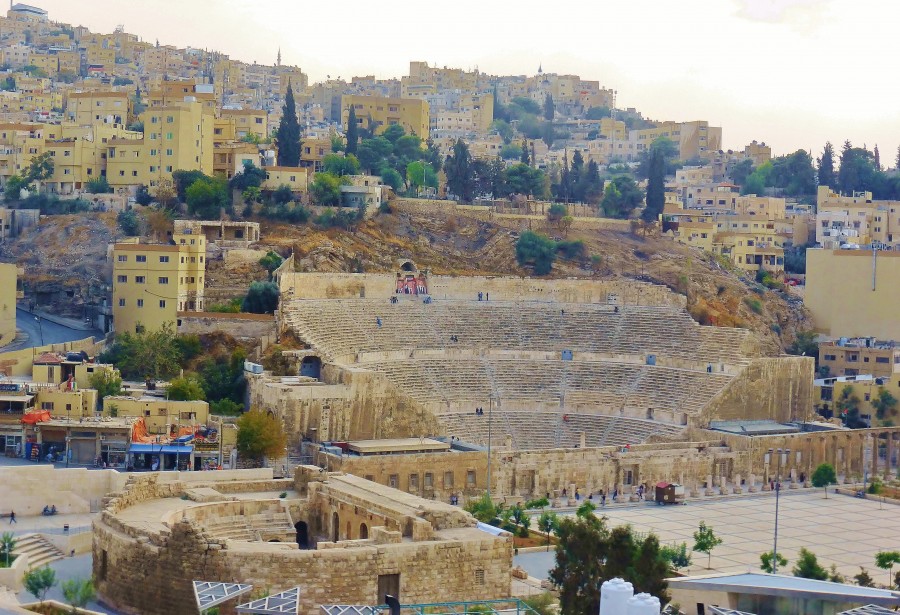
Roman Theater and Hippodrome in Amman.
Around the seventh century Jordan was conquered by Muslims and had no other choice then automatically become a part of the Muslim world. However, regardless of the occupant, no matter whether it was the Roman Empire or the Muslim Ummayad Caliphate Jordan was developing due its location on the trade route. Then, during the reign of the Sunni Abbasid Caliphate (750 – 1258) Jordan was increasingly neglected and that’s why one of the solutions was the transfer of the capital from Damascus to Kufa and then to Baghdad. After the Abbasid ruled weakened Jordan was ruled by various forces, such as: Mongols, Crusaders, Ayyubids and Mamluks, until finally in 1516 Jordan became a part of the Ottoman Empire.
The recent history of Jordan
After the end of World War I the territory covering current Israel, Jordan, West Bank, Gaza Strip and Jerusalem were allocated to Great Britain by the League of Nations, as the mandate of Palestine and Transjordan. However, in 1922 however the British divided the mandate into partially autonomous Emirate of Transjordan, ruled by Prince Abdullah, while Palestine was still under the full authority of the British. Then, on the 22nd of May 1946 Jordan became independent and the British rule over Palestine ended on the 14th of May 1948 – when Israel was founded. As soon as that happened an open war began between the Arab countries and the new country of Israel. Although the war officially ended on the 3rd of April 1949, in reality this war still continues but with breaks. Importantly, part of the peace agreement stated that Jordan would control the West Bank. In theory it was simple and it looked honest but Jews controlling finances and having influence over politics in America had different plans. On the one hand Jews knew the unpredictable nature of Muslims and on the other they wanted more control for Israel.
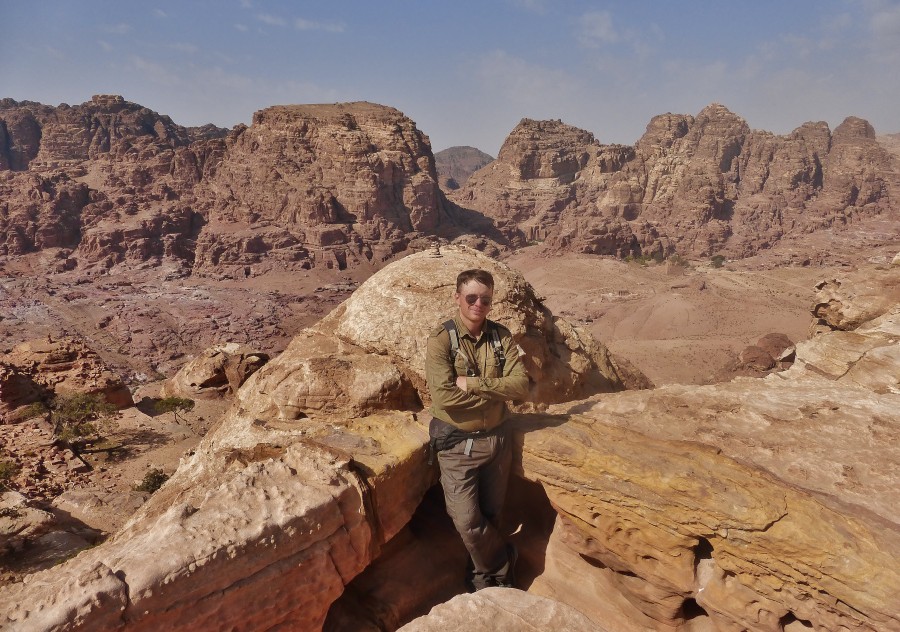
I recommend Jordan.
In 1950 Jordan changed its name to the Hashemite Kingdom of Jordan which included its current territory and a part of Palestine. A key breakthrough however took place in the Six-Day War in 1967 between Israel and the Arab countries, such as: Syria, Egypt, Jordan and Iraq. Israel demolished the Egyptian air force to the ground and increased control over the Middle East to the Jordan River, including Jerusalem. In 1988 Jordan officially gave up its territorial claims to the West Bank and America supported her decision at once and recognized the West Bank as the Israeli territory. After the war Jordan increased the number of Palestinian refugees from about 700.000 in 1966 to 1 million immediately after the war. Jordan is also the only country that gives citizenship to Palestinians. In the meantime Palestinians living in Jordan began to create an organisation called “Fedayeen” which was meant to fight Israel through terrorist attacks. However, the organization threatened primarily the stability of Jordan what led to their expulsion from the country.
Another war was the war in 1973 between the Arab countries and Israel, and although Jordan did not wage an open war against Israel she sent troops to Syria to fight Jews on a foreign ground. Since then Jordan has not fought any wars and also did not participate in the Gulf War, but had a territorial conflict with Syria in 1980. In 1994 Jordan signed a peace treaty with Israel and in 1999 Abdullah II became king and he is to this day. Since then Jordan has struggled with internal problems such as poverty and unemployment as well as with internal problems such as for example the America and Israel created ISIS.

Jordan, alongside Lebanon, has some of the best-preserved Roman ruins. In the picture: Jerash.
We also cannot forget about the “companionship” of Israel, which based on evidence is a terrorist state, the greatest instigator in the region, and it has huge influence over politics, including changing the borders.
Travel reports
Map
Location
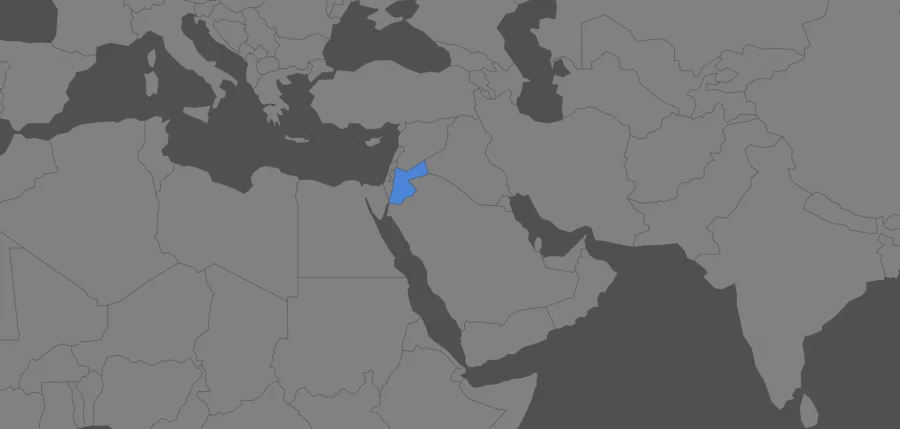
Practical information
Tourist visa: at Amman airport I bought a single-entry visa for 40 JOD which let me stay for 30 days. However, travellers entering Jordan by land from Egypt to Aqaba receive a free visa but only for 14 days. Both of those visas can be extended at police stations for three months. Importantly however, visas cannot be obtained at the Jordanian border crossing with Israel on the King Hussein bridge. Those people who want to immediately get a 3-month visa to Jordan must submit applications at consulates abroad.
Safety: I travelled around Jordan for 3 weeks and I never had any problems. People are helpful, communicative, interested in doing business and in having a simple conversation, but not in crimes. Jordan is a popular tourist destination and one of the safest countries in the Middle East. The main dangers are associated with theft. You should stay away from crowded places to avoid pickpockets and do not participate in political demonstrations. Before arriving I advise to get to know the current situation because Jordan is in a very hot area. Neighbours such as Israel, Syria, Lebanon and all the crazy Arabs from the neighbouring countries can quickly turn tourist haven into a tourist cemetery. Anyway, Jordan is safe.
Moving around the country: is not a problem. Jordan has a well-developed and inexpensive bus network. This does not mean that they are fast or that they depart on time, but in the end they always leave and go to the destination. In theory timetable in Jordan does exist but buses do not leave unless they are full. Apart from that hitchhiking works in Jordan quite well. I travelled by trucks and passenger cars and it was also fun and a way to get to know the country. Women however should keep in mind that there are only women in the Arab country and to them I do not recommend hitchhiking, unless they travel in the company of their husbands.
Prices (for 2015 when 1JOD = £0.98): The currency of Jordan is Jordanian Dinar and in my opinion the conversion is the best into British pounds because it is almost equal with it. In the beginning prices in Jordan discouraged me a little bit because of the high exchange rate, but it was not expensive after all. It is important to acknowledge that in Jordan prices depend on how well tourists can bargain and if they don’t bargain it means that they are either rich or stupid. In Jordan, one can spend a little or a small fortune. Whilst traveling on a strict budget for a room I paid on average 5JOD because for that purpose I was not able to spend more. My meals were the cheapest in the desert in a tent because they were free. For meals I paid roughly 3-5 JOD and for fresh fruit juices and sugar cane drinks in Amman I paid 0.5 – 1JOD. Transport usually cost me 1JOD, even through the mountains from Karak to the Dead Sea. A bus from the airport cost me 3JOD whilst the most I paid for a bus from Wadi Musa (Petra) to the turn off for Wadi Rum – 5JOD. Hitchhiking works well and it is mostly free. There are also tickets to the places of interest and Petra was the most expensive – 55JOD for two days, although I did not pay anything because I got there through a secret canyon and I tricked the guards. (As a Christian I believed that overpaying to Muslims would have been a great lack of manners, so in the name of the Holy Trinity I entered for free). The Baptism Site of Jesus by Jordan river cost me 12JOD and I could not haggle, Mt Nebo cost me 1JOD, Citadel in Amman 3JOD and Jerash unfortunately 10JOD. Wadi Rum was also very expensive (50-150JOD) due to transport but I did it for free and saw everything because I volunteered as a cook for Canadian tourists. That was however an exception, like a blind hen that found a golden grain and that’s why I suggest to not to count on that. All tickets in Jordan are much more expensive for tourists. To sum up, I think that an explorer traveling on a budget, so the one who sleeps in the cheapest hostels for 5JOD and in a tent, who eats in cheap bars and uses cheap local transport and hitchhikes should be prepared to spend about 20JOD a day or 25-30JOD if he uses taxis from time to time. Of course to that we have to add the price of a visa (40JOD), entry tickets and souvenirs, what means that to a whole trip we would have to easily add another 140JOD. To see the most interesting places in Jordan, in my opinion a traveller would need at least two weeks although three weeks allow for a more relaxed pace, especially in the hot, desert climate. If someone really wants to spend very little he has sleep in a tent quite often, he has to hitchhike and cook for Canadians, like I did.
Climate: Jordan is located between the dry deserts of Arabia and sub-tropical humidity of the Mediterranean, what makes the Jordanian climate hot and dry. That’s why the climate of Jordan is characterized by long, hot and dry summers and short and cool winters. The coldest month is January when temperatures range from 5°C to 10°C and the hottest month is August when temperatures are generally from 20°C to 35°C, even though they can sometimes exceed 40°C. In the summer months there are gusty winds that create sandstorms, break trees and limit visibility. Precipitation is most common in the winter months (about 70%) and sometimes cause local storms, erosion and floods.



